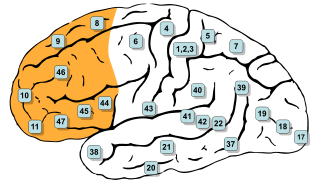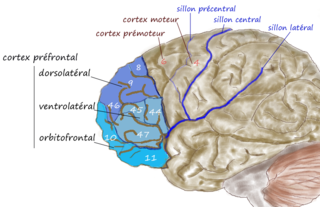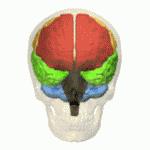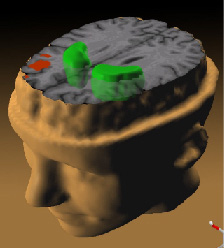Basic background
Executive functions
Executive functions are cognitive processes that control other brain activities and are predominantly functioning in the prefrontal areas of the frontal lobe. Executive functions are limited in capacity and accountable for the initiation, consolidation, regulation, and inhibition of cognitive, language, motor and emotional processes. [2] These processes underlie such functions as self-evaluation, planning, problem solving, controlling impulses and attention, and strategic selection or sequencing of behaviour to reach desired goals. [1] [3]
Measuring executive functions is often less accurate than measuring non-executive tasks because of the interconnectedness and multi-determined complexity of the brain. Executive functions are hard to measure independently of all other cognitive functions and are often influenced by non-executive factors. [3] Consequently, understanding the relationship between behaviours and cognitive processes can be difficult.
Many models of executive functions have been proposed, none of which completely dominates over all others in validity and acceptability. The underlying complexity of the brain makes it very difficult to verify which model(s) are most correct. This article is most focused on the executive function of the Supervisory Attentional System and research pertaining to the system.
Norman and Shallice model (1986)
In 1980/1986, psychologists Donald Norman and Tim Shallice proposed a framework of attentional control of executive functioning. [4] [5] The model uses thought and action schemas which are a series of learned thought and action sequences, like scripts, that specify behaviours during situations. Schemas are activated from perceptual stimuli or from the output of recently activated schemata. For an example, entering your kitchen to find a pile of unclean dishes (input) could initiate a behavioural response to clean (schema). [3] It is postulated that an enormous, finite quantity of thought and action schemata exist [6] and that they range in hierarchy. For instance, high-level schemas represent problem solving while low-level schemas typify actions. [7]
In the Norman-Shallice model, two main processes manage the functioning and control of schemas. Contention scheduling is a lower-level mechanism that regulates schemata processes for familiar, automatic actions as well as some novel situations. [1] Contention scheduling ensures the proper schema is activated and, through inhibition, prevents multiple competing actions from executing simultaneously. [8] Schemas have selection conditions and are initiated if the level of activation reaches threshold. Connected schemata mutually inhibit one another. A schema encountering an increased number of activations will result in easier future access and greater suppression of the activation of those schema connected to it. [9] Several concurrently run schemata, for instance walking and talking, are strengthened by use and take less attentional control. [10] Contention scheduling is fast, automatic, and consistent in activating schema.
The second component of the Norman-Shallice model is the Supervisory Attentional System (SAS). This higher-level mechanism has control over contention scheduling. [1] The SAS monitors conscious, deliberate planning of actions, novel situations that cannot be solved by previously learned schemata and/or when preventing error or habitual responses is critical. [7] In addition to monitoring the activation of an appropriate schema and suppressing inappropriate schemata, the SAS adjusts to solve problems that existing schemata failed to resolve. In other words, it modifies general strategies to solve non-routine problems. If there are no existing schemata related to the issue then under attentional control a new schema may be created, assessed and implemented. [9] The formation of a new schema takes approximately 8–10 seconds. [10] Supervisory Attentional System is slow, voluntary, and uses flexible strategies to solve a variety of difficult problems.
There are two main processing distinctions in attention. Automatic attentional processes do not require conscious control and are triggered in response to familiar, environmental stimuli. This contrasts to controlled attentional processes that require conscious control in order to respond to unique situations.
The SAS is involved in the executive component of working memory [11] to store, control, and process appropriate information. [10] The SAS enables independent behaviour involved in memory, planning, decision making, cognitive estimation, problem solving, dangerous environments, novel situations, error inhibition, error correction, and initiating actions. [10] It also encompasses main components of human attention including selection, divisibility, shift-ability, and sustainability. [7] Selection of attention is the ability to select to a specific task over a more salient stimulus or set of background stimuli[ citation needed ]. Divisibility is when attention is divided among tasks[ citation needed ]. The ability to jump attention from one task to the next is known as shift-ability. Maintaining attention on one task for an extended amount of time is referred to as the sustainability of attention. The SAS also accounts for the priming of anticipated tasks. However a reduced activity in the SAS is corresponded to momentary inadequacies of attention resulting in irrelevant behaviour known as a capture error. When the SAS is unsuccessful in suppressing irrelevant schema attention is adversely influenced. [1] Similarly, patients with a dysfunctional SAS show complication in recalling memories for specific events and problems with focusing attention, planning, and initiating actions. [11]
Another error in the supervisory attentional system can lead to more devastating implications. When humans are faced with a threatening situation there is often limited time to generate the fight-or-flight response ideally suited to increase survival. Cognitive paralysis is when an individual fails to respond or 'freezes' during an emergency because of either a temporal or cognitive deficiency. The inhibition of the SAS is the proposed temporal constraint during an emergency. If an appropriate pre-learned schema is retrievable, then a survival response will be initiated. However, if no existing schemata can respond, the result is cognitive paralysis, otherwise exhibiting irrational behaviour. Based on this understanding, one may wrongly speculate that the SAS is unfavourable in dangerous situations. The supervisory attentional system provides individuals with the ability to predict and prepare for situations mentally prior to any possible encounter. Many have argued about the specific roles of the SAS in survival situations; a general understanding is that it functions to increase the chance of survival and that it operates in conjunction with an integrated system. [10]

The noted probable location of the SAS is in the frontal lobes, [1] more specifically in the prefrontal cortex. [10] This follows in understanding that the frontal lobes provide a framework to reach attainable goals. The dorsolateral region of the frontal lobes is involved in thinking and language, and organizes mental representations of content. [6] The prefrontal cortex accommodates many systems and tasks working independently, dependently, and interacting with the SAS. The SAS functioning depends on multiple specific systems, and structures in the brain. [12] Throughout the 1980s and 1990s, much neuropsychological research was conducted on the frontal lobes and prefrontal cortex (PFC). [9] Over time, the supervisory attentional system was incorporated into research on age, brain injuries, psychological disorders, degenerative diseases, substance abuse and more. The following section is a brief review on research involving the SAS.







